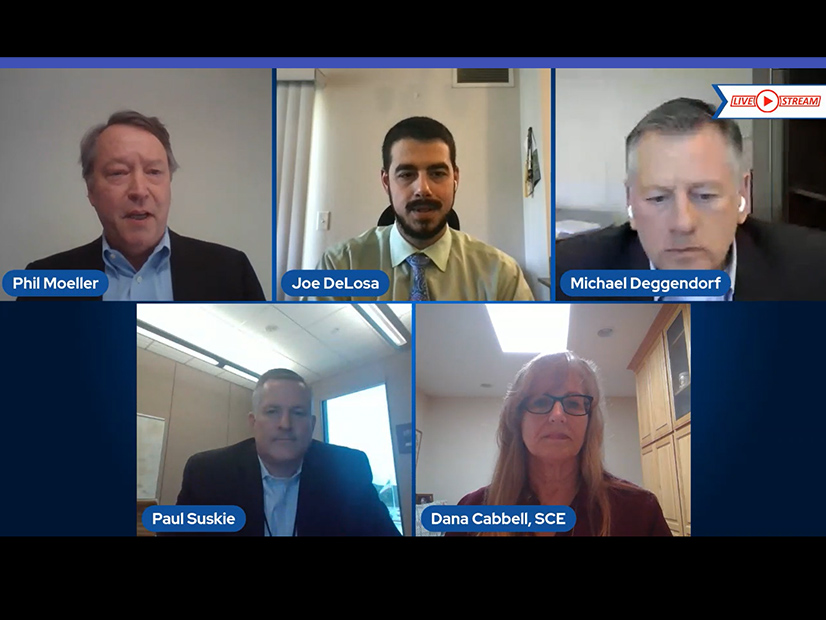More uniformity in transmission planning standards and broader considerations of benefits are needed to ensure the grid can handle increasing renewables and help states meet climate goals, speakers told the Energy Bar Association’s annual meeting Wednesday.
Officials from SPP, American Electric Power, Southern California Edison and the New Jersey Board of Public Utilities shared their recommendations in a session titled “Transmission is the Answer: The Question is Can We Build It?”
Michael Deggendorf, AEP’s senior vice president for regulated infrastructure development, said planners should expand the “value proposition” of interregional transmission to include geographical load, resource diversification and reducing curtailments of renewables.
But he said inconsistencies in regional planning standards are preventing interregional projects, calling on FERC to set “minimum bulk power transfer standards” to support reliability and resilience.
“We think that will give the RTOs the comfort and the authority to build that sort of planning assumption into their established planning processes,” he said.
He also said the commission should require all grid operators to use transmission planning “best practices,” including longer planning horizons and use of “multiple and robust” scenarios that treat projects as having “multivalue benefits.”
“Each RTO has an element of these best practices today, but they don’t line up particularly well,” he said. “That’s why we see the challenges of getting benefits to align on an interregional basis.”
Planners have consistently underestimated the penetration rates of renewable generation “and, because of that, underinvested in the transfer capabilities within the region and outside the region,” he added.
Also needed is better alignment of state needs and federal policies, he said, citing a transmission project in Pennsylvania and Maryland whose need was identified by PJM in 2014. Transource Energy, a joint venture of AEP and Evergy, was awarded the project in 2016. “We’re still waiting for the final state approval to start construction,” he said.
Although the Maryland Public Service Commission approved a settlement allowing the project to proceed last June, it has not been cleared by Pennsylvania regulators. (See Md. PSC OKs Independence Energy Connection Deal.)
Dana Cabbell, director of integrated system strategy for SCE, agreed with the need for longer planning horizons, saying the 10-year focus should be extended to 25 years.
In California, she said, it takes 10 to 12 years between conceiving a project and putting it into service. “It’s just too long, especially as we’re looking [to meet climate goals in] 2045. We should have started last year.”
Cabbell listed six grid “challenges” that she said current transmission solutions don’t address, including bidirectional power flows; maintaining system stability despite increasing distributed energy resources; and a loss of system inertia as inverter-based resources supplant traditional synchronous generators. She also cited limited power supply in locally constrained areas to support high density loads such as electric vehicle transport corridors.
“These challenges are showing up today at a smaller scale but will grow and reach critical mass around the mid-2030s,” she said.
Joe DeLosa, chief of the New Jersey BPU’s federal and regional policy bureau, said FERC should revise Order 1000’s fourth cost allocation principle, which limits allocation to within a single transmission planning region unless those outside voluntarily assume costs.
It “really constrains the ability for the commission to assign beneficiaries to other regions,” he said. “If there is a more holistic evaluation of the benefits, I think that would be a marked improvement.”
He also complained about what he called the “siloed nature” of transmission planning in PJM.
“The supplemental project planning process [done by incumbent utilities] never talks to the [PJM] market efficiency planning process, [which] never talks to the” state agreement approach under Order 1000, he said. “Customers are spending lot of money on supplemental projects without those projects being necessarily the most efficient to also solve their public policy needs.”
The BPU initiated the state agreement approach in asking PJM to seek bids on transmission upgrades to support New Jersey’s goal of 7,500 MW of offshore wind by 2035. If the state pursues the upgrades, it would be required to pay for them in full, although they would also benefit others in PJM. (See New Jersey Seeks OSW Transmission Ideas.)
“Seeing whether a larger project could obviate other projects is not something, as I understand it, that really occurs in the PJM planning process today,” DeLosa said. “And I see that as one of the main obstacles to broadening the planning process to consider these other clearly important public policy goals.”
Paul Suskie, executive vice president and general counsel of SPP, said FERC should reconsider its policies on generator interconnection queues.
“If you have a generating resource that has a [power purchase agreement] or a load-serving entity that has state commission approvals already to build, I think they need to move to the front of the line,” he said. “Speculative generators, I think, are bogging up the queue and creating real delays and hindering good transmission getting built.”
Noting the rapid changes in the generation mix he added: “The model of 100 years ago is not going to work in the future.”






